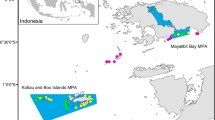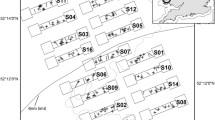Abstract
Utilizing marine protected areas (MPAs) to isolate the ecological effects of human influence can help us understand our effect on systems and foster ecosystem-based approaches to management. Specifically, examining invertebrate prey community dynamics inside and outside an MPA may provide a measure of how altering human influence (i.e., certain fishing pressures) affects ecosystem interactions. We measured trophic interactions inside and outside a deep-water temperate MPA over 2 years. Predation rates on tethered, preferred groundfish prey (crabs) were initially identical inside and outside the MPA, but decreased outside the MPA after the commercial groundfish fishing season commenced. Predation trials using a ubiquitous prey species (brittle stars) and a less preferred prey species (urchins) served as controls, showing no MPA effect. Our experiments quantify differential predatory activity resulting from differences in human activity driven by an MPA, demonstrating important effects of fishing and regulations on the strength of trophic interactions.




Similar content being viewed by others
References
Babcock RC, Kelly S, Shears NT, Walker JW, Willis TJ (1999) Changes in community structure in temperate marine MPAs. Mar Ecol Prog Ser 189:125–134
Collette BB, Klein-MacPhee G (eds) (2002) Bigelow and Schroeder’s fishes of the gulf of maine. Smithsonian Institution, Washington, D.C.
Edgar GJ, Barrett NS (1999) Effects of the declaration of marine reserves on Tasmanian reef fishes, invertebrates and plants. J Exp Mar Biol Ecol 242:107–144
Estes JE, Smith NS, Palmisano JF (1978) Sea otter predation and community organization in the western aleutian islands. Ecology 59(4):822–833
Fogarty M, Murawski S (1998) Large scale disturbance and the structure of marine systems: fishery impacts on Georges Bank. Ecol Appl 8(1):S6–S22
Gerber LR, Botsford LW, Hastings A, Possingham HP, Gaines SD, Palumbi SR (2003) Population models for marine MPA design: a retrospective and prospective synthesis. Ecol Appl 13(1):S47–S64
Grizzle RE, Ward LG, Malik MA, Cooper AB, Abeels HA, Greene JK, Brodeur MA, Rosenberg AA (2009) Effects of a large fishing closure on benthic communities in the western Gulf of Maine: recovery from the effects of gillnets and otter trawls. Fish Bull 107(3):308–317
Holbrook SJ, Schmitt RJ (1986) Food acquisition by competing surfperch on a patchy environmental gradient. In: Simenstad A, Cailliet GA (eds) Contemporary studies in fish feeding: the proceedings of GUTSHOP ‘84. C, pp 135–146
Howell WH, Morin M, Rennels N, Goethel D (2008) Residency of adult Atlantic cod (Gadus morhua) in the western Gulf of Maine. Fish Res 91:123–132
Jackson JBC, Kirby MX, Berger WH, Bjorndal KA, Botsford LW, Borque BJ, Bradbury RH, Cooke R, Erlandson J, Estes JA, Hughes TP, Kidwell S, Lange CB, Lenihan HS, Pandolfi JM, Peterson CH, Steneck RS, Tegner MJ, Warner RR (2001) Historical overfishing and the recent collapse of coastal ecosystems. Science 293:629–638
Lester SE, Halpern BS, Grorud-Colvert K, Lubchenco J, Ruttenberg BI, Gaines SD, Airame S, Warner R (2009) Biological effects within no-take marine reserves: a global synthesis. Mar Ecol Prog Ser 384:33–46
Malik MA (2005) Identification of bottom fishing impacted areas using multibeam sonar and videography, MS Ocean engineering thesis. UNH Durham NH, 125 pp
McCarthy K, Gross C, Cooper R, Langton R, Pecci K, Uzmann J (1979) Biology and geology of Jeffreys ledge and adjacent basins: an unpolluted inshore fishing are, Gulf of Maine, NW Atlantic. ICES Annual science conference CM 1979, E: 44
McClanahan TR, Mangi S (2000) Spillover of exploitable fishes from a marine park and its effect of the adjacent fishery. Ecol Appl 10(6):1792–1805
Micheli F, Amarasekare P, Bascompte J, Gerber LR (2004) Including species interactions in the design and evaluation of marine MPAs: some insights for a predator-prey model. Bull Mar Sci 74(3):653–669
Murray SN, Ambrose RF, Bohnsack JA, Botsford LW, Carr MH, Davis GE, Dayton PK, Gotshall D, Gunderson DR, Hixson MA, Lubchenco J, Mangel M, MacCall A, McArdle DA, Ogden JC, Roughgarden J, Starr RM, Tegner MJ, Yoklavich MM (1999) No-take MPAs: sustaining fishery populations and marine ecosystems. Fisheries 24(11):11–25
National Oceanic and Atmospheric Administration (1999) Our living oceans: report on the status of US living marine resources. NOAA Tech Memo NMFS-F/SPO-41
New England Fishery Management Council (1998) Northeast Multispecies Fishery Management Plan Framework 25, April
New England Fishery Management Council (2006) Northeast Multispecies (Large Mesh/Groundfish) Fishery Management Plan, Management plan overview. http://www.nefmc.org/nemulti/summary/large_mesh_multi.pdf.
Pauly D, Christensen V, Dalsgaard J, Froese R, Torres F (1998) Fishing down marine food webs. Science 279:860–863
Safina C, Rosenberg AA, Myers RA, Quinn TJ II, Collie JS (2005) US Ocean fish recovery: staying the course. Science 309:707–708
Sala E, Boudouresque CF, Harmelin-Vivien M (1998) Fishing, trophic cascades, and the structure of algal assemblages: evaluation of an old but untested paradigm. Oikos 82:425–439
Selig E, Bruno J (2010) A global analysis of the effectiveness of marine protected areas in preventing coral loss. PLoS ONE 5(2). doi:10.1371/journal.pone.0009278
Sobel J, Dahlgren C (2004) Marine reserves: a guide to science, design, and use. Island Press, Washington
Steneck R, Carlton J (2002) Human alterations to marine communities: students beware. In: Bertness MD, Gaines SD, Hay ME (eds) Marine community ecology. Sinauer Press, Sunderland, pp 445–468
Tognelli MF, Fernández M, Marquet PA (2009) Assessing the performance of the existing and proposed network of marine protected areas to conserve marine biodiversity in Chile. Biol Conserv 142:3147–3153
Vadas RL, Steneck RS (1995) Overfishing and inferences in kelp-urchin interactions. In: Skjoldal HR, Hopkins C, Erikstad KE, Leinaas HP (eds) Ecology of Fjords and coastal waters. Elsevier, Amsterdam, pp 509–524
Wahle RA, Steneck RS (1992) Habitat restrictions in early benthic life–experiments on habitat selection and in situ predation with the American lobster. J Exp Mar Biol Ecol 157(1):91–114
Walters C, Christensen V, Pauly D (1997) Structuring dynamic models of exploited ecosystems from trophic mass-balance assessments. Rev Fish Biol Fisheries 7:139–172
Witman JD, Sebens KP (1992) Regional variation in fish predation intensity: a historical perspective in the Gulf of Maine. Oecologia 90:305–315
Acknowledgments
Thanks to A. Baukus, L. Carlson, E. Dewey, J. Driscoll, P. Kendall, C. Mavrikas, and J. Smith for their tremendous efforts in the field. I. Altman, A. Blakeslee, M. Carr, A. Freeman, J. Grabowski, B. Griffen, R. Grizzle, H. Lenihan, T. Lee, A. Rosenberg, S. Teck, and L. Ward were helpful in shaping this project. Both the Cooperative Institute for New England Mariculture (CINEMar; grant # 111463) and the Northeast Consortium provided generous funding for this project.
Author information
Authors and Affiliations
Corresponding author
Additional information
Communicated by P. Kraufvelin.
Rights and permissions
About this article
Cite this article
Meyer, J.J., Byers, J.E. Human-driven spatial and temporal shift in trophodynamics in the Gulf of Maine, USA. Mar Biol 158, 631–638 (2011). https://doi.org/10.1007/s00227-010-1587-1
Received:
Accepted:
Published:
Issue Date:
DOI: https://doi.org/10.1007/s00227-010-1587-1




